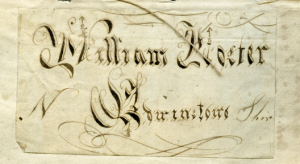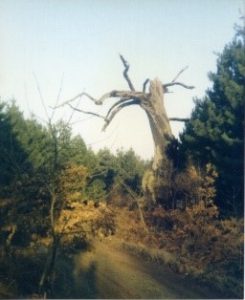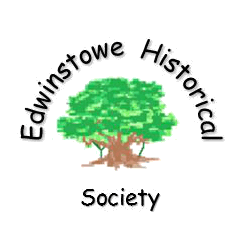Richard Neil, a sailor, who had survived crossing the Atlantic, the Bay of Biscay and fighting the French drowned in Thoresby Lake. He is buried in Edwinstowe churchyard.

Thoresby Hall

Family Crest above the fireplace in the new Thoresby Hall

Thoresby Lake
The Society has been given a dilapidated Book of Common Prayer which was rescued from a house clearance in Derby. It is inscribed on the flyleaf in beautiful copperplate writing William Foster Edwinstowe, date of birth April 22nd 1777. William, Ann (1778) and John (1780) were the children of Sarah and Simon Foster Cordwainers (Leatherworkers/Shoemakers).


Simon Foster died aged 65yrs on 20th January 1800 and is buried in St Mary’s churchyard:
Death little warning to me gave,
But quickly sent me to the grave;
So haste to Christ make no delay,
For no-one knows their dying day.
His Will left everything to his wife. Disappointingly for curious historians, instead of an Inventory of Goods, she simply declared their value:
Short Beech Close; goods and chattels; flock of sheep; money; securities and debts. Total £269. After her death in 1818 the Estate was to be divided between their three children.
Churchwardens Tax Accounts of 1803 list Sarah Foster and son William, Cordwainers.
Richard Neil married Elizabeth Dale on 15th April 1789 at the inland port of Gainsborough. Where the Bridegroom’s Parish should be written in the Marriage Register it just says “Sailor”. The names and birth dates of their four children all baptised at St Mary’s Church Edwinstowe are listed in the Prayer Book: John 5th June 1790, Louisa 13th June 1792, Evelin* (see below) 28th Aug 1794 and Richard Brook 2nd Sept 1798.
In January 1800, a double tragedy occurred. Richard Neil, recently returned to Thoresby, and his friend John Birdsall, who had only married Fanny two days earlier, were drowned whilst crossing Thoresby Lake. Their gravestone in St Mary’s churchyard tells the story:
 Attend, this awful monitor to mans security
Attend, this awful monitor to mans security
Richard Neil, who after having braved
The boisterous billows of the Biscan shore
The gaping terrors of the rude Atlantic
And fulminating wrath of haughty France,
In fights victorious at 32 in vital plenitude
And the meridian of well-earned friendships,
By some disastrous unforeseen event
Yealded his social life
To the minutia of his element
In Thorseby Lake
As did the partner of his fleeting breath
John Birdsall, of youthful 28
But just immersed in joys hymenial
Anxious to meet his loving expecting bride
Was too arrested by the liquid wave.
Alike deserving and alike beloved
Fell two lamented youths
Together in one unpropitious night
The 29th of January 1800
And this earth Their mortal parts retain
 Nottingham Journal Saturday Feb 1st 1800 reported,
Nottingham Journal Saturday Feb 1st 1800 reported,
‘A melancholy accident happened on Wednesday evening last in Thoresby Park as Richard Neil cordwainer and John Birdsall whitesmith, both of Edwinstowe, were crossing the lake in a canoe (although expressly cautioned against it.) It filled and they were unfortunately drowned. The former has left a wife and four young children, the latter was only married on Monday last. Both were generally esteemed and are much regretted.’
In 1790, Richard Neil is listed in the Thoresby Disbursements (account books) receiving £20 per year responsible for sailing vessels on the Lake. Earl Manvers family’s naval background was reflected in the park: “Thoresby Hall stands in the centre of a wide park, 10 miles in circumference.
 To the west of the house is a lake, formed by the river Medin, sometimes adorned with a handsome miniature vessel.
To the west of the house is a lake, formed by the river Medin, sometimes adorned with a handsome miniature vessel.

A replica of the Mary Yacht, 1689, was sailed on the lake.

Thoresby Estate
This broad and magnificent sheet of water is protected at its eastern extremity by a mimic battery, consisting of a mortar and guns, some of the latter apparently of Spanish origin. At the western side on a commanding and picturesque eminence, is the residence of ‘the sailor’ an old naval companion of his Lordship’s, a modern erection known as *Fort William and protected in like style. On the south margin of the water is a monument to the memory of two former inhabitants of Edwinstowe, one a mariner called Neil, the other, Birdsall, who were drowned while crossing the lake on a stormy evening on 29 January 1800 in a canoe. Several of the woods and groves around are named in memory of naval heroes”. (Eddison 1854)

*Fort William is now called Budby Castle and was built to house the crews of these boats. The Captain of the Mary, an old sailor, lived and died at the Castle William, a picturesque, ivy-covered house.
https://britishlistedbuildings.co.uk/101045478-budby-castle-perlethorpe-cum-budby#.X4xNKtBKg2w
This urn was erected as a tribute due to them and as a caution to others.

Fair laughs the moon and soft the zephyr blows,
While proudly riding o’er the azure realm;
In gallant trim the gilded vessel goes,
Youth at the prow, and pleasure at the helm.
Regardless of the sweeping whirlwind’s sway.
That, hushed in grim repose, expects his evening prey. [Thomas Gray]
During 1800 his Lordship continued to pay Richard Neil’s wages to his widow and employed Fanny Birdsall in the kitchens. He also paid a widow’s pension to Sarah Foster who made shoes for the children at Budby school.
On 8th December 1800 Richard Neil’s widow Elizabeth, mother of 4 small children, married William Foster at Edwinstowe. Their son Simon was born in 1801 and Neil Foster was “born Nov 11 1809 at half past 3 o’clock in the afternoon.”
Simon Foster used to secure his stock under a tree in Sherwood Forest as a shelter from sun and rain and during the night for protection, and from that time it has borne his name – the Simon Foster’s Oak.


Drawing by J. Rodgers Simon Foster’s Oak 1985
Elizabeth died in 1827 aged 61yrs. In the 1841 Census William Foster’s occupation is given as Shoemaker. He died in Southwell Union Workhouse in April 1853 and was buried at Edwinstowe aged 76 yrs.
*On Ancestry, The Francis Norfolk Pietrmaritzburg Family Tree shows that Evelin Neil married Elizabeth Slater and they had three children in Cape Province South Africa:
Louisa 1822, Sophia 1828 and Sarah 1829.
Our thanks to: Gary Severn (finder of the book); Barbara Tapper Thoresby History Group; Staff of the Manuscript Dept. University of Nottingham Archives re: Manvers papers; Helen Fox, Local Studies Librarian. Thoresby Hall (Warners) for permission for use of photographs of the hall and fireplace
Other inscriptions in the Prayer Book read:
“Andw Crawshaw Rotherham Rockley No 2944”
“Neil Foster Born Nov 11 1809 at half past 3 o’clock in the afternoon” [not so far identified]
“Elizabeth Foster died December 22 1827 two o’clock in the afternoon”
“William Holt Book Given to him by his Godfather on Oct 27 1840 Radcliffe Nottinghamshire”.
Also, a Funeral Hymn beginning “Hark from the tomb a doleful sound”]
 Edwinstowe Historical Society
Edwinstowe Historical Society